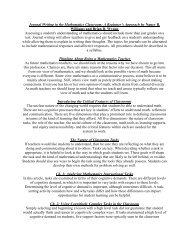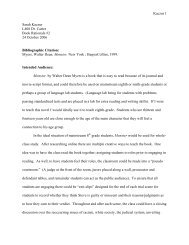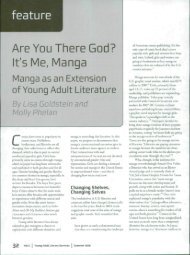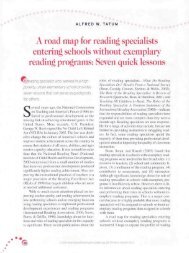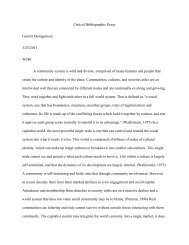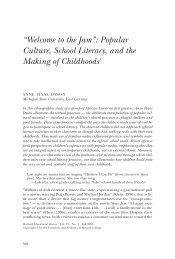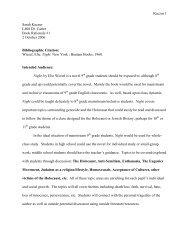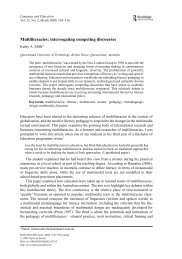Grauerholz 2003 Assessing critical thinking sociology.pdf - Oncourse
Grauerholz 2003 Assessing critical thinking sociology.pdf - Oncourse
Grauerholz 2003 Assessing critical thinking sociology.pdf - Oncourse
- No tags were found...
Create successful ePaper yourself
Turn your PDF publications into a flip-book with our unique Google optimized e-Paper software.
CRITICAL SOCIOLOGICAL THINKING 493Table 3. Results of factor analyses using all<strong>critical</strong> sociological <strong>thinking</strong> items.Compo- Component1 nent 2Uses examples .821 -.005Examples pertinent .797 .150Reasoning .904 .004Bias .456 .308Two-sides .836 -.007Aware social structure .859 .008Aware historical contexts .218 .740Aware cross-cultural .168 -.703Use sociological concepts .766 .008Critical <strong>thinking</strong> (holistic) .938 .004Sociological imagination(holistic) .941 .007Table 4. Reliability analyses for combined"<strong>critical</strong> sociologicai <strong>thinking</strong>" scale.Corrected Item-Total CorrelationUses examples .774Examples pertinent .740Reasoning .867Two-sides .783Aware social structure .825Use sociological concepts .708Critical <strong>thinking</strong> (holistic) .912Sociological imagination(holistic) .926Scale mean = 3.94Standard deviation = .873Alpha coefficient = .9502McPeck's (1990) understanding of <strong>critical</strong><strong>thinking</strong> as discipline-specific and isgrounded in Geertsen's (<strong>2003</strong>a) notion of<strong>critical</strong> judging and his two-sided conceptionof referential <strong>thinking</strong>, which encompassesboth <strong>critical</strong> and reflective <strong>thinking</strong>.Thus, we argue that while there may besome basic <strong>critical</strong> <strong>thinking</strong> skills and abilitiesthat are applicable to any subject matteror problem (e.g., avoid emotional reasoning),<strong>critical</strong> <strong>thinking</strong> within <strong>sociology</strong> islikely to reflect different skills than <strong>critical</strong><strong>thinking</strong> in another discipline. Critical<strong>thinking</strong> within <strong>sociology</strong>, or <strong>critical</strong> sociological<strong>thinking</strong>, requires sociologicalknowledge and awareness. This knowledgeconsists not only of concepts but, more importantly,employs the sociological imagination.In this type of <strong>thinking</strong>, students perceiveand understand that their individuallife choices, circumstances, and troubles areshaped by larger social forces such as race,gender, social class and social institutions.We also developed empirical measures of<strong>critical</strong> sociological <strong>thinking</strong> that we hopewill promote greater exploration into howand under what conditions students learn.Most of the measures developed for thisstudy demonstrate high construct and convergentvalidity. That is, eight of the elevenitems tested were highly correlated andloaded on a single factor. Thus, we proposean eight-item Likert scale, consisting ofitems generally associated with referential<strong>thinking</strong> (Geertsen <strong>2003</strong>a). Several itemstap the students' ability to bring reasonableevidence to bear on an argument (e.g., usesexamples that are meaningful and pertinentto the argument) while others tap students'ability to engage their sociological imaginations(e.g., indicates awareness of socialstructural contexts).The three items tested in this study thatdid not perform well in the factor analysisincluded "awareness of historical contexts,""awareness of cross-cultural contexts," and"bias" (appeals to prejudice, prevailingideas and information while demonstrating opinion, feelings). We suspect that the veryawareness of broader social and cultural weak correlations between cross-culturalcontexts. This concept is consistent with awareness and other items results from the



